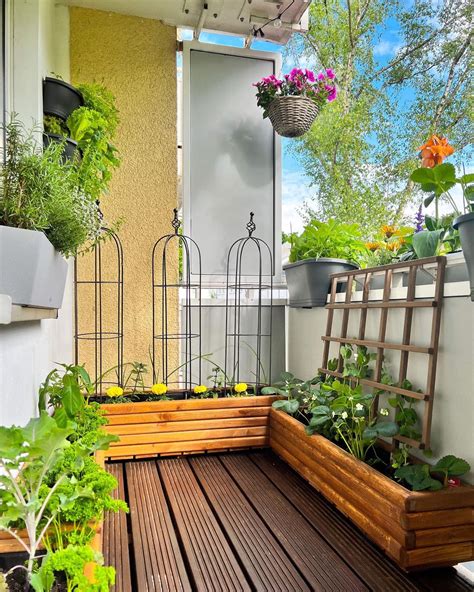Smart Planting Techniques to Maximize Your Balcony Space for Gardening
Urban living often limits the amount of outdoor space available for gardening. However, with smart planting techniques, even a small balcony can become a lush green oasis. Whether you’re interested in growing herbs, flowers, or vegetables, maximizing your balcony space is possible through thoughtful planning and efficient use of resources. This guide explores strategies to help you optimize your balcony garden, ensuring a healthy and productive green space.
Key Concepts in Balcony Gardening
Balcony gardening offers a unique set of challenges, but also numerous opportunities for creativity. To get the most out of your small space, it’s essential to understand key concepts like smart planting, container gardening, and vertical gardening.
- Smart Planting: Selecting the right plants for your space based on their growth habits, sun requirements, and how well they adapt to container living.
- Container Gardening: Using pots, raised beds, or other containers to grow plants. This technique is essential for urban environments where soil access is limited.
- Vertical Gardening: Optimizing vertical space by growing plants on trellises, walls, or shelves, allowing more plants to fit in a small area.
Historical Context of Urban Gardening
The practice of growing plants in urban areas dates back centuries. In ancient civilizations like Babylon, the famous Hanging Gardens were a marvel of urban green space. During the World Wars, citizens were encouraged to create “Victory Gardens” in cities, using rooftops and balconies to grow food as part of a collective war effort. Fast-forward to the present, urban gardening is a popular trend driven by the need for sustainable living, healthier diets, and a desire for nature in compact living spaces.
Current State Analysis: Urban Gardening Today
As cities become denser, more people are turning to balcony gardening to enjoy the benefits of nature and grow their own food. However, there are several challenges, including limited sunlight, wind exposure, and space restrictions. Advances in plant breeding, such as the development of dwarf plant varieties, have helped overcome some of these obstacles, making it easier for urban dwellers to succeed in balcony gardening. In addition, new gardening tools and containers designed for small spaces offer innovative solutions to maximize growing potential.
Practical Applications: Smart Planting Techniques
To maximize your balcony space, follow these smart planting techniques:
- Choose the Right Plants: Opt for compact, dwarf, or climbing plant varieties that make the most of vertical space. Herbs like basil and thyme, dwarf tomatoes, and climbing beans are excellent choices.
- Use Multi-Purpose Containers: Some planters come with multiple compartments or stacking options to allow more plants in a smaller footprint. Use hanging baskets to add greenery without taking up valuable floor space.
- Install Shelving or Vertical Trellises: By going vertical, you free up floor space while creating a structured and aesthetically pleasing arrangement.
- Utilize Smart Irrigation Systems: Balcony gardens can dry out quickly due to sun and wind exposure. Consider self-watering containers or drip irrigation systems to ensure consistent moisture.
Case Studies: Successful Balcony Gardens
| City | Space Used | Plant Varieties | Smart Planting Techniques |
|---|---|---|---|
| New York City | 50 sq. ft. balcony | Herbs, dwarf tomatoes, salad greens | Vertical shelving, self-watering pots |
| Tokyo | 30 sq. ft. balcony | Peppers, beans, small fruit trees | Wall-mounted planters, trellises |
| Paris | 25 sq. ft. balcony | Lavender, strawberries, ornamental plants | Hanging baskets, multi-compartment pots |
Stakeholder Analysis in Balcony Gardening
Balcony gardening impacts a variety of stakeholders, including:
- Urban Residents: Gain access to fresh food and nature in limited space.
- Environmental Advocates: Promote sustainability through green living and reducing urban heat islands.
- Local Governments: Support balcony gardening initiatives to improve urban ecosystems and public health.
Implementation Guidelines for a Successful Balcony Garden
- Start Small: Begin with easy-to-grow plants like herbs or lettuce and gradually expand as you gain experience.
- Assess Light and Wind Conditions: Ensure your balcony receives adequate sunlight (6 hours for most plants) and consider wind barriers like mesh or plants that serve as windbreaks.
- Choose the Right Containers: Use containers that are deep enough for root growth and have proper drainage holes.
- Regular Maintenance: Prune, water, and fertilize regularly to keep plants healthy and thriving.
Ethical Considerations in Urban Gardening
As urban gardening grows in popularity, ethical considerations must be addressed:
- Water Conservation: Balconies may require more frequent watering due to exposure. Using water-efficient techniques, such as mulching and drip irrigation, is vital for sustainability.
- Plant Sourcing: Use local or ethically sourced plants to avoid contributing to the invasive species problem or supporting exploitative labor practices.
- Pesticide Use: Avoid harmful chemicals that could negatively impact local biodiversity, especially in dense urban areas.
Limitations and Future Research
Despite its growing popularity, balcony gardening has limitations. Space constraints and environmental factors, such as limited sunlight or excessive wind, can impact plant health. Future research should focus on developing more resilient plant varieties and innovative gardening technologies tailored to urban environments. Additionally, studies on the social and psychological benefits of urban gardening could provide insights into its broader impact on urban communities.
Expert Commentary on Balcony Gardening
Experts agree that balcony gardening is not only feasible but also a rewarding endeavor for urban residents. Jane Smith, an urban agriculture specialist, states, “With the right tools and techniques, even the smallest balcony can be transformed into a productive garden.” Dr. Robert Green, a horticulturist, emphasizes the importance of plant selection: “Choosing plants that suit your environmental conditions is key to a successful balcony garden.” Lastly, urban planner Laura White notes, “Balcony gardening can have a significant impact on mental well-being and community engagement, especially in dense urban areas.”


